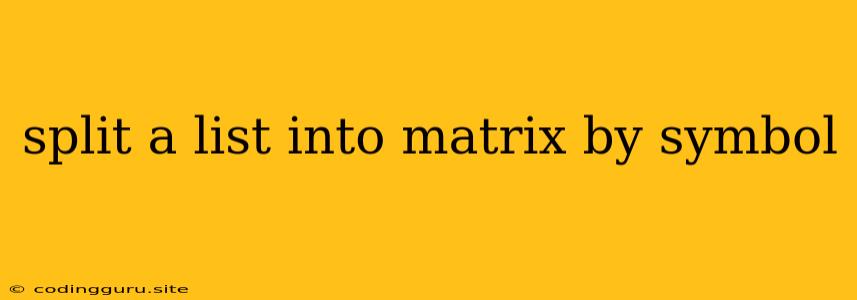Splitting a List into a Matrix by Symbol: A Comprehensive Guide
Have you ever encountered a situation where you had a list of data, separated by a specific symbol, and needed to neatly organize it into a matrix? This common task can be a bit tricky, but with the right approach, it becomes quite manageable. In this article, we will delve into the process of splitting a list into a matrix by symbol, exploring different methods and providing practical examples to illustrate the concepts.
Understanding the Problem
Before we dive into solutions, let's clarify what we're trying to achieve. Imagine you have a list like this:
data = "Apple,Orange,Banana;Peach,Grape,Mango;Strawberry,Blueberry,Raspberry"
This string contains information about different fruits, separated by commas (,) within each row and by semicolons (;) between rows. Our goal is to transform this list into a matrix, where each row represents a fruit group:
matrix = [
["Apple", "Orange", "Banana"],
["Peach", "Grape", "Mango"],
["Strawberry", "Blueberry", "Raspberry"]
]
Splitting the List into Rows
The first step is to separate the data into individual rows based on the semicolon (;). We can achieve this using the split() method:
rows = data.split(';')
This will create a list of strings, each representing a row of the matrix.
Splitting Rows into Columns
Now, we need to further split each row into individual columns using the comma (,) as our separator:
matrix = []
for row in rows:
columns = row.split(',')
matrix.append(columns)
This code iterates through each row and uses the split() method again, this time with a comma as the delimiter, to create a list of columns. Finally, each column list is appended to the matrix.
Python Implementation
Let's combine these steps into a concise Python function:
def split_list_to_matrix(data, row_delimiter, column_delimiter):
rows = data.split(row_delimiter)
matrix = []
for row in rows:
columns = row.split(column_delimiter)
matrix.append(columns)
return matrix
data = "Apple,Orange,Banana;Peach,Grape,Mango;Strawberry,Blueberry,Raspberry"
matrix = split_list_to_matrix(data, ';', ',')
print(matrix)
This function takes the data string, the row delimiter, and the column delimiter as inputs, and returns the resulting matrix.
Alternative Methods
While the above approach works well, there are other ways to achieve the same result. You can use list comprehensions for a more concise syntax:
matrix = [row.split(',') for row in data.split(';')]
This single line of code achieves the same outcome as the previous code block.
Handling Different Delimiters
The provided code assumes that the row and column delimiters are semicolons and commas, respectively. However, the function can easily be adapted to handle different symbols. For example, if the delimiters are spaces and hyphens:
data = "Apple Orange Banana - Peach Grape Mango - Strawberry Blueberry Raspberry"
matrix = split_list_to_matrix(data, ' - ', ' ')
print(matrix)
This demonstrates the flexibility of the function to handle various delimiter combinations.
Conclusion
Splitting a list into a matrix by symbol is a fundamental task that arises in various data manipulation scenarios. By understanding the core concepts and utilizing appropriate methods, you can effectively transform your data into a structured matrix representation. Remember to adapt the code based on your specific delimiters and data structure, and consider using efficient methods like list comprehensions to streamline your code.
